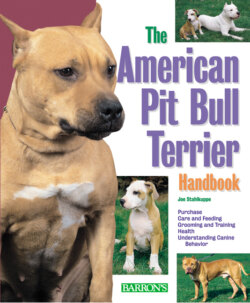Читать книгу American Pit Bull Terrier Handbook - Joe Stahlkuppe - Страница 30
На сайте Литреса книга снята с продажи.
Bullbaiting
ОглавлениеFierce mastiff dogs had long bedeviled bulls and bears. Germany had its bullenbeisser (bull biter) and barenbeisser (bear biter). Originally hunting mastiffs, these “biters” suddenly joined their distant relatives all over Europe in a new blood sport—the baiting of bulls and bears. As bears became rarer and harder to obtain, more and more attention was paid to battling bulls. Arenas were no longer available, but every village and town had its butcher shop/slaughter house. Bulls were baited—chained and then attacked by one or more dogs—in the town square and in any open areas where a crowd might easily view the spectacle.
Large, heavy-bodied mastiffs had plenty of courage, but their lack of quick and agile mobility caused many giant dogs to die in the bull-to-dog encounters. Quicker dogs, more successful in surviving these encounters, soon began to dominate the gene pool of bullbaiting dogs. In other countries, quicker dogs also began to replace the larger, slower mastiffs in battling bulls and the occasional bear.
The emergence of these quicker, lighter, and more agile dogs brought a resurgence of interest in bullbaiting contests. These improved new dogs were called by what they did, the canines were called “bulldogs,” and they gradually replaced the mastiff breeds in several countries. The regions that had once boasted of their local mastiffs soon were touting the abilities of their local bulldogs. The bulldogs would prove to be more adaptable and more entertaining than their predecessors and achieved great popularity. Merchants and other travelers, much like the Romans had done with the mastiffs, soon spread bulldogs throughout the world.
